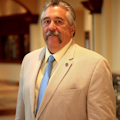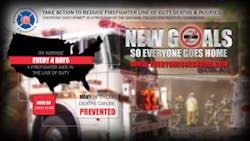NFFF “New Goals” Campaign: Taking Steps to Survivability
Often, the path to sustained change is through incremental improvements. Of course, some issues are so important they must be dealt with immediately. But, in general, by prioritizing what needs to be accomplished and taking small, manageable steps we see progress occur that is both sustainable and important.
Over the past decade, the fire service has followed this philosophy to reduce line-of-duty injuries and deaths. Since the first Tampa Summit in 2004 and the creation of the 16 Firefighter Life Safety Initiatives, fire service leadership, departments, stations and individuals have focused on making safety a priority.
The Summit and the Initiatives are often cited as the crux of the “Culture of Safety” and, unbelievably in my mind, have drawn considerable criticism over the years. As we all know, some people believe it was an attack on the traditions and culture of firefighting. But as I’ve said before, that was never the intent. The goal was to get firefighters – from veteran leadership to the newest recruits – to take a hard look at the risks versus the benefits in precarious situations before charging into the unknown. Taking a few moments to assess whether lives are at stake and can be saved without causing more lives to be lost could chip away at the number of line-of-duty deaths and injuries our fire service family experiences each year.
By emphasizing personal safety through training and education, we’ve seen the number of injuries and fatalities on the fireground begin to decline. It’s reason for hope. But it’s not the entire solution. “Safety,” it turns out, is just part of this giant puzzle. We need to take another step forward and look at the bigger picture. I think now is the time to emphasis “Survivability” in our fire service vocabulary and embrace this concept in our understanding of culture. The reality is Survivability is interwoven throughout each of the 16 Firefighter Life Safety Initiatives.
Tampa 2, held this past March, was an opportunity to help refine and ratify all 16 Initiatives. Important questions were raised about improving our Survivability. Clearly, messages have been getting through about the importance of education and training to adopt safer practices. But the truth is the reason firefighters are dying isn’t only about the risks taken on fire ground operations. Survivability is about proper training, arriving to a scene safely and departing safely, eating a healthy, balanced diet, exercising more, wearing and maintaining personal protective equipment (PPE) properly and understanding that repeated exposure to toxins can lead to chronic and terminal illnesses.
On the surface, the 16 Firefighter Life Safety Initiatives sound like a lot of work and tough to implement. And it doesn’t matter if you come from a small department, one that depends completely on volunteers, a large metropolitan department, a department that isn’t adequately funded or somewhere in between. Embracing all of these steps can be overwhelming.
It doesn’t have to be. No one believes that all 16 Initiatives can be adopted in short order. This will result in frustration, not Survivability. The key to success is strategically planning those steps you can implement in the immediate, intermediate and long range.
Do what you mother told you as a kid – eat more vegetables and fruits, fewer snacks and get outside and move around. You don’t have to be a star athlete, but you do need to be physically active. I’m sure she also reminded you to wear your seatbelt and drive carefully. Far more line-of-duty deaths are a result of heart attacks, strokes and vehicle accidents than from fireground events.
Survivability means taking control. When you get back from a call, talk to each other about what went right and what needs to be corrected. Then talk about it some more with others who weren’t on that call. Don’t sit in front of the TV or scroll through your social media updates. Work on fixing what went wrong by training. And plan for other incidents. Prepare for what could be coming with the next call by practicing. If you do it all the time and think about the unexpected, you won’t be thrown off when “the Big One” does come. Institute the After Action Review every time wheels roll – from responding to an incident to training exercises. Every time. Take proper care of your PPE. And by all means, make – and keep – annual appointments with your healthcare provider.
Survivability means taking care of each other. When things start swirling around and you’re feeling overwhelmed, reach out to a trusted friend, family member or health professional. If you notice that others on your crew just don’t seem quite like their usual selves, take a few minutes to ask how they’re doing. Let them know you will listen or help them find someone who will.
All this might sound like simple, old-fashioned advice. But it’s what helps us power through each day. It’s called Survivability and it’s the next step each of us needs to take to reducing the number of our brothers and sisters who die each year.
RON SIARNICKI is executive director of the National Fallen Firefighters Foundation. For further coverage of the NFFF’s “New Goals” campaign, see http://www.firehouse.com/article/12030839/tampa-2-report-unveiled.
About the Author

Ronald Siarnicki
National Fallen Firefighters Foundation
Fire Chief Ronald Jon Siarnicki began his career as a firefighter with the Prince George's County Fire/EMS Department in 1978 and with 24 years of fire, rescue, and emergency medical services operational experience, he has progressed through the ranks to Chief of the Department. In this position he served as the Chief Executive Officer responsible for the fire, rescue and emergency medical services of Prince George's County, Maryland. In July of 2001, Chief Siarnicki retired from the Prince George?s County Fire/EMS Department to take the position of Executive Director of the National Fallen Firefighters Foundation in July of 2001. He is a graduate of the Masters Program, School of Management and Technology, at the University of Maryland, University College, College Park, Maryland and has a Bachelor of Science Degree in Fire Science Management from UMUC. He is a certified Fire Officer IV, Fire Fighter Level III, and State Emergency Medical Technician. He has served as a UMUC faculty member for the Fire Science Curriculum since 1997.
